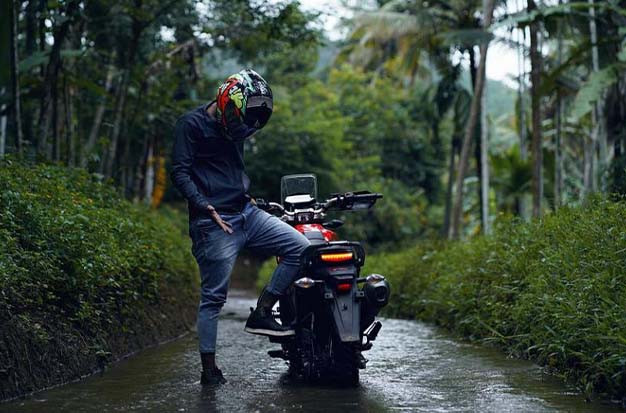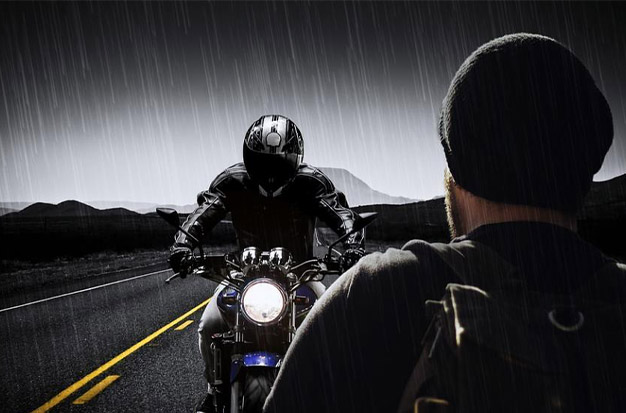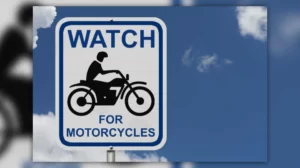Experienced motorcycle riders will advise you to make every effort to avoid riding in the rain. When you attempt to navigate slick conditions with only two wheels, you put your balance and control at risk, putting yourself in an unsafe situation.
Even though riding a motorbike in the rain is risky, there are several simple safety measures you can take to keep yourself safe. Only ride in the rain if it is absolutely necessary, and make sure you are wearing all the necessary equipment to keep visible to other cars. In the rain, driving safely is equally essential.
We’ll go into greater detail about the kinds of safety measures you ought to employ when riding a motorcycle in the rain below. We’ll also go over some safe driving practices you may employ when biking in the rain.
Is It Dangerous To Ride A Motorcycle In The Rain?
Riding a motorcycle in the weather might be risky. Sincerely, riding a motorcycle anywhere, at any time, can be deadly. There are particular problems to cope with while it’s raining. Since it’s not always possible to foresee when a storm will begin, you need to take extra precautions to reduce your chances of getting caught in one.
Before riding in the rain, you should exercise caution because there are numerous factors to take into account. A condensed list of these safety measures includes avoiding rain unless absolutely necessary, carrying special equipment in case you get stranded, and being visible to other vehicles.
What Gear Do You Need To Ride A Motorcycle In The Rain?
Whenever you plan to go somewhere with a high probability of rain, it is a good idea to have rain gear on hand. You’ll need to pay attention to your hand and visor gear. As with your car’s windshield, maintaining the good vision of the road is crucial, so you don’t want your helmet’s visor to fog up and obstruct it. However, it goes beyond just your personal visibility.
It’s crucial to invest in visor equipment that won’t fog up or reduce your visibility in the rain. However, it’s as crucial to be seen by other motorists. Get a reflective vest or other brightly colored clothing that will make you very visible to other vehicles.
Six Tips On How To Ride A Motorcycle In The Rain
Although it’s never a good idea to ride a motorcycle in the rain, there are instances when it’s the only option. The best piece of riding advice you’ll ever receive is to completely avoid riding in the rain. When you try to drive on only two wheels on slick surfaces, you put yourself at risk. Rain quickly compromises your balance and control, but there are techniques to maximize your safety even in the worst conditions.

Here are six pointers for motorbike riding in the rain:
Check To See If Your Tires Can Handle The Wet Road
The first thing you should consider is whether or not your motorcycle tires are capable of handling a slick road. Stop reading now if you have slippery tires and avoid wet roads at all costs until you can afford some stickier tires.
There are many tires on the market that provide you with additional stability and control. These tire protectors will keep you in control of the bike and moving in the right direction during rainy conditions.
Smoother And Wiser Riding
When biking in the rain, keep the term smooth in mind. Everything you do while riding a motorbike in wet conditions should be fluid, including adjusting the throttle, braking, and maneuvering. There’s a reason why modern motorcycles frequently come with a Rain mode that reduces power, possibly even smooths out the throttle mapping, and/or boosts ABS and traction control involvement.
Use your lean angle wisely, even when using contemporary rider aids, and roll the throttle on and off slowly. If you encounter a slippery patch, keeping your bike as upright as you can lessen the likelihood that it will slide out from beneath you. Instead, widen your following space, use your engine to assist in slowing down, and brake smoothly.
Pay Attention To Road Hazards
The road will feel very different from when you’re riding in dry circumstances while it’s raining. A car is also a lot simpler to drive in the rain than a motorcycle. When it rains, surfaces like manholes, railroad tracks, and concrete slabs are all made even more slippery for motorcycle riders.
As much as you can, try to stay away from these obstructions, and be cautious of any puddles. Even if it appears that the rain puddle is only a few millimeters deep, it may potentially be concealing a considerably deeper pothole.
When you’re riding in the rain, you must stay focused on riding on clear road paths and know that any pooling, gravel, or tree branches in the road have a completely different effect on your riding than compared to being on four wheels.
Brake And Accelerate Slowly
Why not use the same safety precautions that are advocated for cars—slow braking and acceleration—on your motorcycle? Make sure you’re moving slowly enough to allow you to brake properly if you’re riding in traffic. You need sufficient space to stop without sliding.
You should also try to accelerate gradually because your back tire might be on a manhole or a particularly slippery surface. You can lose control and spin out as a result of this.
Choose The Right Gear
The first step to enjoying a day spent in the rain is to dress in appropriate waterproof clothing, such as a rain suit (two-piece or one), gloves, boots, and possibly an electric heated vest, to keep you warm and dry in even the most persistent storm. Although high-visibility clothing isn’t the most fashionable, it enhances the likelihood that other drivers may notice you in low-light situations, so keep that in mind as you look for gear. Although rain is predicted, think about packing a number of lighter layers that you may add to if you start to feel chilly. Waterproof gear usually adds warmth on its own.
The helmet, which needs to include an anti-fog visor (such as Pinlock), a breath guard, or even a visor with an electric defrost function, is another sometimes forgotten component of the equipment puzzle. The last thing you need is an obscured vision of a wet road, so either leave the tinted shield at home or bring a replacement clear one. If at all possible, keep your visor down and closed at all times. It would be very challenging to defrost once rain or moisture gets inside.
Make sure that any gear combination you choose doesn’t interfere with or otherwise distract you from riding. For instance, frozen fingers make it impossible to operate the controls, yet extra-warm gloves might be too cumbersome and not much better. Similar to a neck warmer, which may keep you nice and warm but prevent you from turning your head far enough to examine your shoulder. Finding the appropriate equipment may take some searching, but you should be able to strike a good balance between comfort and usefulness for the riding conditions you intend.
If you commute while biking in the rain, always have a change of clothes at your desk.
Watch Out For Surprises
Situations that are almost harmless in dry weather might become nasty surprises when it’s raining. Watch out for manhole covers, tar snakes (sealer pavement), painted lines, and fallen leaves because when they’re wet, they all resemble black ice. Check to see if there is a line you can take to get around any of these traction inhibitors before you run into them. If not, roll over them without applying any forceful inputs and avoid severe braking or acceleration.
Another potential risk is standing water, which is particularly hazardous on freeways where high speeds could prohibit you from slowing down in time to avoid hydroplaning. Of course, where there is less elevation, water will collect, and on freeways, it is typically in the left-most lane where the concrete barrier stops it from draining. Avoid utilizing that lane and keep an eye out for water spray on the automobiles in front of you to identify problem spots early.
Conclusion
The hazards of riding a motorcycle in the rain demand additional safety measures. But rain-riding can be made safer if done correctly. Riding a motorbike in the rain can be safe as long as you prepare your route in advance, wear the proper protection, and pay attention to people around you.



